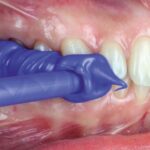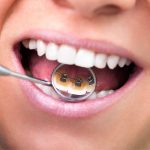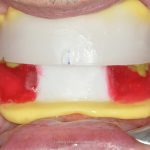Bite registration precision is an aspect of crucial importance for the fabrication of satisfactory prosthetic restorations (1–3).
Of all the materials used for bite registration, elastomers are the latest innovation in the field (2).
Characterised by excellent dimensional stability, they are easy to handle and are not felt by patients during the occlusion phase (4).
After curing, they are easy to alter, because they can be cut or relined. At the same time, these materials ensure high surface detail reproduction precision (5).
The characteristics and advantages of addition silicones (polyvinylsiloxanes)
More specifically, addition silicones consist of an organic matrix of vinyl-polysiloxane reinforced with glass-silicate filler particles (6).
Thanks to elemental and molecular analyses using SEM (scanning electron microscopy), it has been observed as some of these materials, especially the scannable variants, also have a high titanium dioxide (TiO2) content,which makes it more reflective and therefore satisfies the requirements for CAD/CAM optical scanning (6).
On the other hand, as curing tests have shown, the setting reaction of these polymers seems to propagate in all directions of the material as soon as the base and catalyst come into contact, and for a short time also after the actual material setting time (6).
The quantities of catalyst can vary from one material to another depending on the reaction rate to be achieved, and range from approximately 20-40 ppm to more than 200 ppm (7).
Polyvinylsiloxanes can be subject to the curing shrinkage that is inherent in all polymers, especially immediately after the mixing of the base and catalyst (6).
However, the highest shrinkage values recorded are consistent with vertical discrepancies of less than 10 µm (6), and therefore within the range for physiological tooth movements (8).
In addition, the fact that polyvinylsiloxanes are devoid of reaction by-products ensures the bite registration some dimensional stability (9).
This aspect is particularly relevant from a clinical point of view, because it ensures that the interocclusal relationship is properly transferred to the articulator models (6,10).
Polyvinylsiloxanes: disadvantages and possible critical issues
The greatest potential disadvantage lies in the fact that any compression applied to addition silicones during the articulation of the stone models can result in imprecision (11).
Indeed, being elastomers, these materials behave like natural rubber and this can cause imperfect positioning on the articulator (11).
It is therefore important for them to be sufficiently elastic to be easily removed from the mouth, yet sufficiently rigid to resist deformation during the articulation of the models (12).
Bite registration material must be chosen with care, since compressive strength depends not only on thickness, but also and above all on the rigidity of the material, which even varies from one A-silicone to another (1,13,14). These are also the reasons why specific materials are used for bite registration instead of conventional impression materials.
Another potential problem might be due to the complex morphological characteristics of the occlusal surfaces of the teeth, which can make it difficult to re-adapt the material from registration to the stone models during the articulation phase.
According to some authors, this problem can be overcome by incorporating the bite registration material into the impression, so that it is useful for both casting the stone models and transferring occlusion (15).
The importance of the material’s usage technique
The above considerations show the importance of the technique with which the bite registration material is used. It is equally important to use the material in the manner that best suits the clinical case.
Depending on the intraoral conditions, the practitioner will have to opt for the most appropriate material and technique combination. (1).
According to Prasad et al. (16), in the presence of a stable maximum tooth intercuspation position, bite registration may not be necessary.
On the other hand, when occlusion is unstable, if it is necessary to record the intermaxillary relationship for the entire arch, it is advisable to use elastomeric materials.
Otherwise, if it is needed only for certain segments or teeth, bite registration can be carried out using stiffer materials such as resin, gypsum or zinc oxide paste (16,17).
For each dentist, therefore, the choice of bite registration material must be judicious.
Want to find out more about bite registration techniques?
Read our focus: Bite registration materials: which one to choose?
Taking into account the various factors and the physical and chemical characteristics of each material, even within the same family, dentists must be able to address this matter, which although often neglected in actual fact is of significant importance, equivalent to that of the impression phase.
The timeless quality of Zhermack Occlufast Rock
Present in dental practices for more than 30 years, Occlufast Rock is still one of the best-known and most popular materials in the world.
The many scientific publications on this addition silicone make it a product of election for bite registration. For further details on the range, consult the Occlufast System Brochure.
References
1) Wieckiewicz M, Grychowska N, Zietek M, Wieckiewicz W. Evaluation of the Elastic Properties of Thirteen Silicone Interocclusal Recording Materials. Biomed Res Int. 2016;2016:7456046.
2) Thanabalan N, Amin K, Butt K, Bourne G. Interocclusal Records in Fixed Prosthodontics. Prim Dent J. 2019 Nov 1;8(3):40–7.
3) Sweeney S, Smith DK, Messersmith M. Comparison of 5 types of interocclusal recording materials on the accuracy of articulation of digital models. Am J Orthod Dentofacial Orthop. 2015 Aug;148(2):245–52.
4) Mobilio N, Catapano S. Effect of experimental jaw muscle pain on occlusal contacts. J Oral Rehabil. 2011 Jun;38(6):404–9.
5) Craig RG. Review of dental impression materials. Adv Dent Res. 1988 Aug;2(1):51–64.
6) Hatzi P, Tzakis M, Eliades G. Setting characteristics of vinyl-polysiloxane interocclusal recording materials. Dent Mater. 2012 Jul;28(7):783–91.
7) Gelest Inc. Reactive silicones: forging new polymer links. Morrisville PA:4–10.
8) Davies SJ, Gray RJ, Linden GJ, James JA. Occlusal considerations in periodontics. Br Dent J. 2001 Dec 8;191(11):597–604.
9) Lozano F, Sanchez F, Agüero P, Munive-Degregori A, Ambrocio E, Mayta-Tovalino F. Variability of Dimensional Stability of Different Interocclusal Recording Materials According to Time: A Comparative: in vitro: Study. Journal of International Oral Health. 2021 Feb;13(1):65.
10) Freilich MA, Altieri JV, Wahle JJ. Principles for selecting interocclusal records for articulation of dentate and partially dentate casts. J Prosthet Dent. 1992 Aug;68(2):361–7.
11) Campos AA, Nathanson D. Compressibility of two polyvinyl siloxane interocclusal record materials and its effect on mounted cast relationships. J Prosthet Dent. 1999 Oct;82(4):456–61.
12) Megremis S, Tiba A, Vogt K. An evaluation of eight elastomeric occlusal registration materials. J Am Dent Assoc. 2012 Dec;143(12):1358–60.
13) Nagrath R, Lahori M, Kumar V, Gupta V. A Comparative Study to Evaluate the Compression Resistance of Different Interocclusal Recording Materials: An In Vitro Study. J Indian Prosthodont Soc. 2014 Dec;14(Suppl 1):76–85.
14) Murray MC, Smith PW, Watts DC, Wilson NF. Occlusal registration: science or art? Int Dent J. 1999 Feb;49(1):41–6.
15) Tripodakis AP, Vergos VK, Tsoutsos AG. Evaluation of the accuracy of interocclusal records in relation to two recording techniques. J Prosthet Dent. 1997 Feb;77(2):141–6.
16) D KP, Prasad BR, D AP, Mehra D. INTEROCCLUSAL RECORDS IN PROSTHODONTIC REHABILITATIONS – MATERIALS AND TECHNIQUES – A LITERATURE REVIEW. Journal of Health and Allied Sciences NU. 2012 Sep;02(3):54–60.
17) Anup G, Ahila SC, Vasanthakumar M. Evaluation of dimensional stability, accuracy and surface hardness of interocclusal recording materials at various time intervals: an in vitro study. J Indian Prosthodont Soc. 2011 Mar;11(1):26–31.
Do you want more information on Zhermack Dental products and solutions?
Contact us




 Zhermack SpA has been one of the most important producers and international distributors of alginates, gypsums and silicone compounds for the dental sector for over 40 years. It has also developed solutions for the industrial and wellbeing sectors.
Zhermack SpA - Via Bovazecchino, 100 - 45021 Badia Polesine (RO), Italy.
Zhermack SpA has been one of the most important producers and international distributors of alginates, gypsums and silicone compounds for the dental sector for over 40 years. It has also developed solutions for the industrial and wellbeing sectors.
Zhermack SpA - Via Bovazecchino, 100 - 45021 Badia Polesine (RO), Italy.


